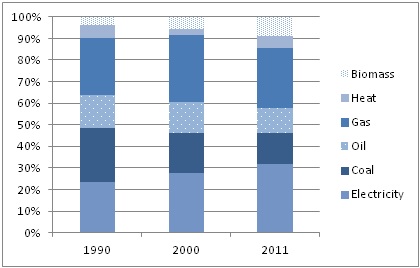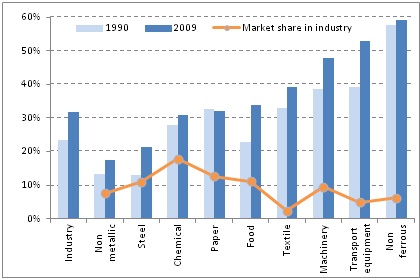Over the last 20 years, coal consumption and -to a lesser extent- oil consumption have steadily decreased to the advantage of electricity in the European industry. In the meantime the natural gas penetration slowed down, stabilizing during the 2000s. What are the uses of electricity in industry? What are the reasons for this large penetration?
Electricity covers a rising share of industrial energy needs
The share of electricity in industrial energy consumption, namely the electrification rate, grew from 23% in 1990 to 32% in 2011 whereas the share of coal dropped from 25% to 14% and that of oil from 15% to 12%. On the other hand, the share of natural gas dropped from its peak of 32% in 2001 to 27% in 2011. Electricity ranked third behind coal and natural in 1990 and went on to become a leading energy source in industry during the 2000s.
Share of electricity in industrial energy consumption

Source: Global Energy and CO2 Data - Enerdata
The electrification rate increased in all main branches except paper. The largest progression took place in transport equipment (+14 points), food (+11 points), machinery (+9 points) and the steel industry (+8 points). Non-ferrous is historically the industrial branch with the highest electricity penetration.
Electrification rate by industrial branch in the European Union

Source: Global Energy and CO2 Data - Enerdata
The change in the industry structure (i.e. an eventual shift to more electricity intensive industries) does not explain the electricity penetration. Calculating the industrial energy consumption in 2010 by assuming the same share of industrial branches as in 1990 does not impact the breakdown by energy in 2010. The diffusion is found to be mainly caused by two factors. Firstly, the development of electric uses in the industry, such as motive power linked to an increase mechanisation, and secondly, fuel substitutions in production processes (electric steel process, electric furnaces for glass making, etc).
 Energy and Climate Databases
Energy and Climate Databases Market Analysis
Market Analysis